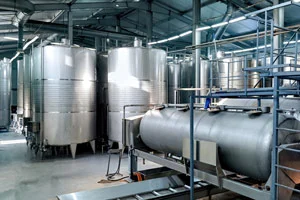Chat with experts | Interview with Miguel Martínez
At Agrovin, Miguel’s team of technical advisors is in permanent contact with the wineries during the grape harvest period, to get to know their needs closely and help resolve any possible problems that arise during this period immediately, thanks to Agrovin products.
Currently, Miguel is responsible for the technical advisory department both internally and in the winery. He also participates in the development of new products and production strategies and has been a part of the Technological Innovations department for several years, developing new winemaking technologies, which has given him a broader vision of the sector and the needs of the wineries.
In general terms, how was the 2021 harvest?
2021 can be defined as an atypical harvest. We have been hearing the same general comments from winemakers, telling us that this is a different harvest in terms of times and the homogeneity of the grapes.
We have come out of the pandemic, where restrictions in the hospitality industry have had significant consequences for the wine sector, but there was a lot of optimism thanks to the improved situation after the pandemic with the consumption of wine, but weather conditions have caused the harvest to be more complicated than expected.
In addition, it has been a shorter harvest season. The Interprofessional Wine association forecasts a decrease at the national level of around 15% compared with last year. This decrease has been more pronounced in the rest of the large European producers, such as France and Italy.
What were the main problems encountered by the wineries this year?
During the past few years, climate change has had an impact on the vine cycle, and short-cycle varieties are being harvested earlier and earlier due to the high temperatures which hasten their ripening. This forces technicians to be very attentive to the ripening controls to ensure the grape’s maximum potential.
And this year has been no different. In those southernmost areas of the peninsula, in the earliest varieties, grapes were showing advanced saccharimeter maturity during the month of August, mainly caused by head waves during that time, and this resulted in grapes with a higher concentration of sugar and uncontrolled acidity, polyphenols and aromas. However, September was a stormy month with high levels of rainfall. These rains during the middle of the season had a mixed effect. On the one hand, those healthier vineyards saw an increase in the volume of berry varietals, but those who saw the greatest changes were very clearly damaged by having to advance their harvest, since there was a risk of the appearance of Bortrytis.
What solutions does Agrovin offer to resolve these problems?
How has Agrovin helped winemakers this season?
During the harvest, our work mainly involves accompanying the winemakers, to remain up to date with the situation experienced in the vineyard and the consequences this can have during the preparation of the wines. Therefore, we had to adapt to the production protocols to a situation that was changing week by week. Working in different wine-growing regions provides us with more up-to-date information on the global situation and allows us to offer the tools to best adapt to each situation. At AGROVIN, not only do we offer our product portfolio, but also the experience and staff trained to deal with years like this.
As an example, I can tell you about two protocols that we have recommended this harvest season: for those red wines coming from grapes with little polyphenolic maturation, we at AGROVIN have proposed the use of our US ULTRAWINE_PERSEO and our ULISES pumping system, maximizing the extraction during the very beginning of the maceration, making it possible to discover the must in FA at higher densities, thus avoiding the extraction of the most astringent compounds and producing aromatic wines with a good color intensity.
Moreover, when producing white wines with grapes affected by rottenness, we at AGROVIN have proposed the use of gallic and ellagic tannins during the entry of the grapes into the winery. This way, we can minimize oxidation by making the lactic bacteria inactive. We also advise the use of MICROSTAB PH, based on fungal chitosan, to reduce the must’s microbial load, and the nutrient ACTIMAX VARIETAL, which protects from oxidation during AF and ensures proper nutrition of the yeast by avoiding possible fermentation and the application of a rapid implantation yeast.
What is Agrovin’s role now that the harvest is over?
Although in many areas, the grapes have already been harvested, the wines are not yet ready for consumption. There is a lot of work left to do in the winery.
It is important to get to know the wines to start working to refine them, promoting color stabilization, protecting the wines from oxidation… We continue to be present in the wineries, helping to supply oxygen with our Dosiox equipment, evaluating the redox situation with Electrowine, all combined with our wide range of refinement and stabilization products.
We also haven’t forgotten that there are many malolactics to work with and now is an ideal situation for the use of lactic bacteria, taking advantage of the optimal temperatures we still have at the wineries.
And here is where we produce our liquid lactic bacteria.
How will this year’s wines turn out?
From my experience, i can see that even after this complicated harvest, as described above, the completed wines have achieved the expected quality. This is mainly due to the hard work of those responsible for the wineries and the contribution of the solutions provided by industries outside the wine sector we have managed to develop thanks to the great research work carried out year after year.


